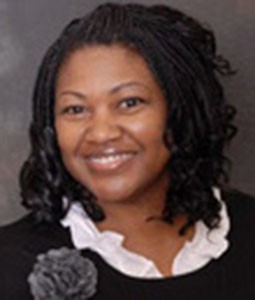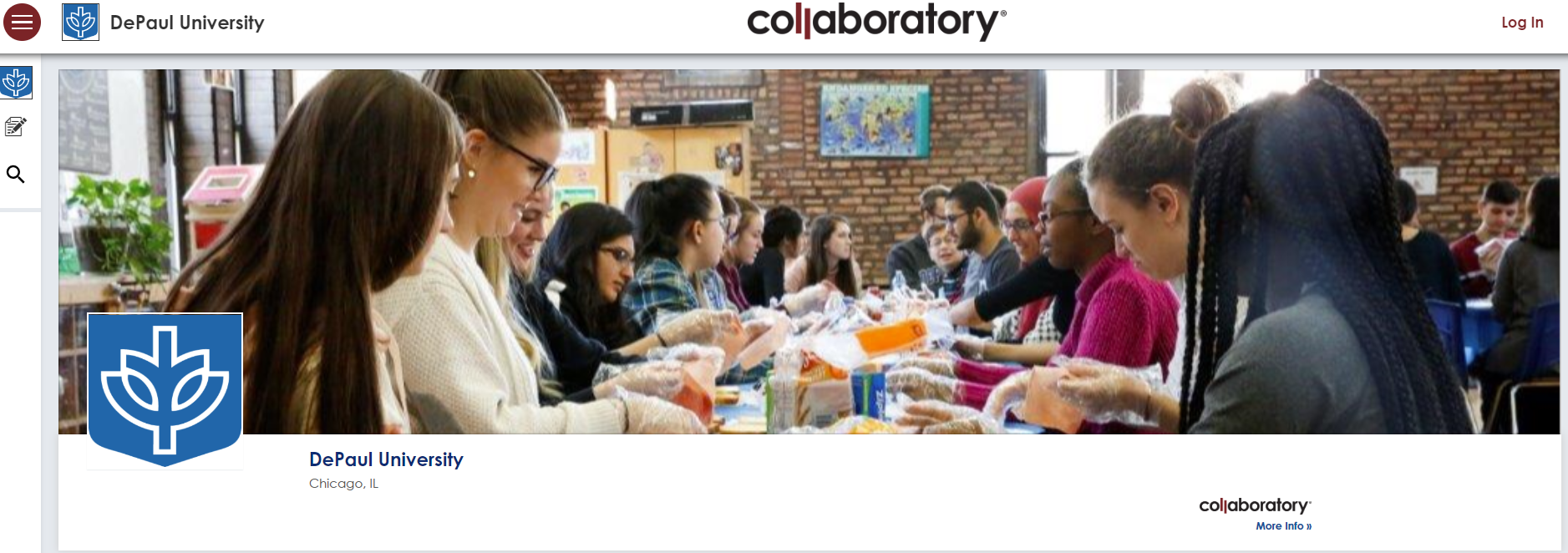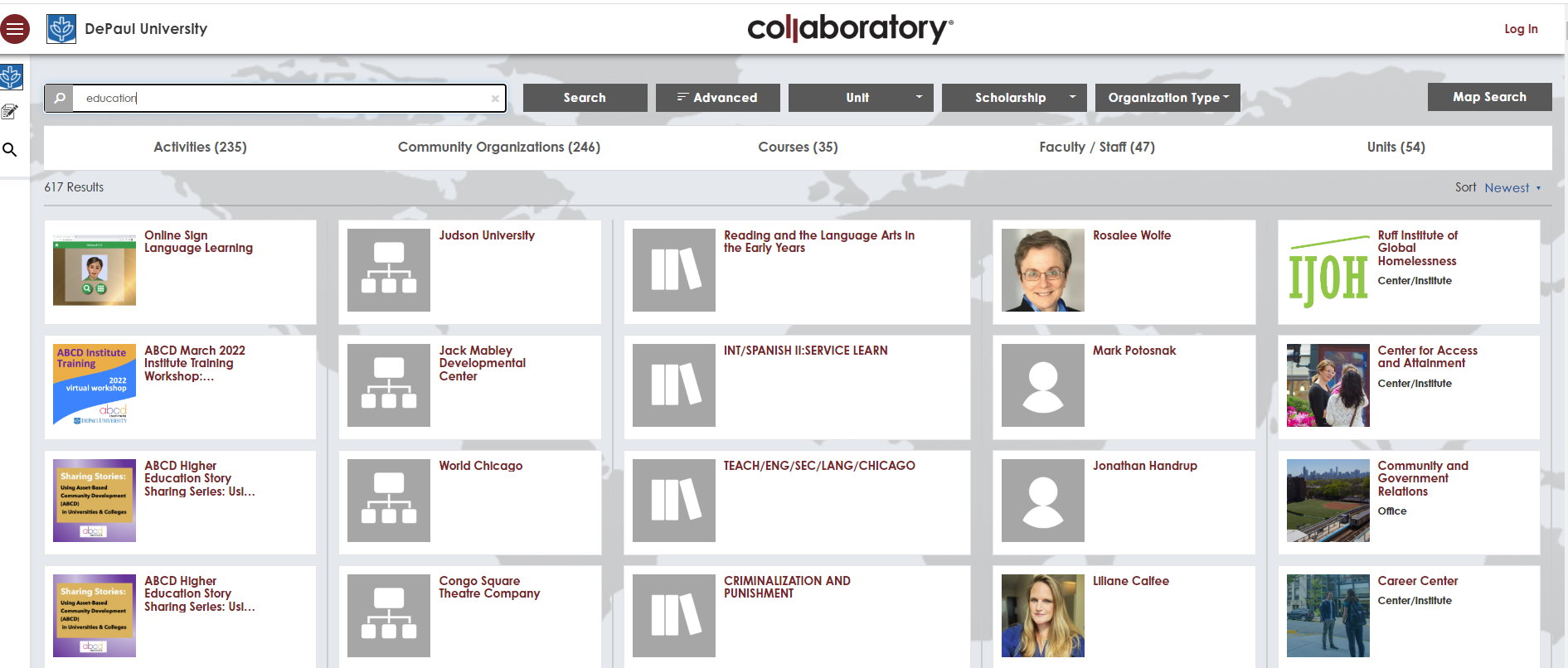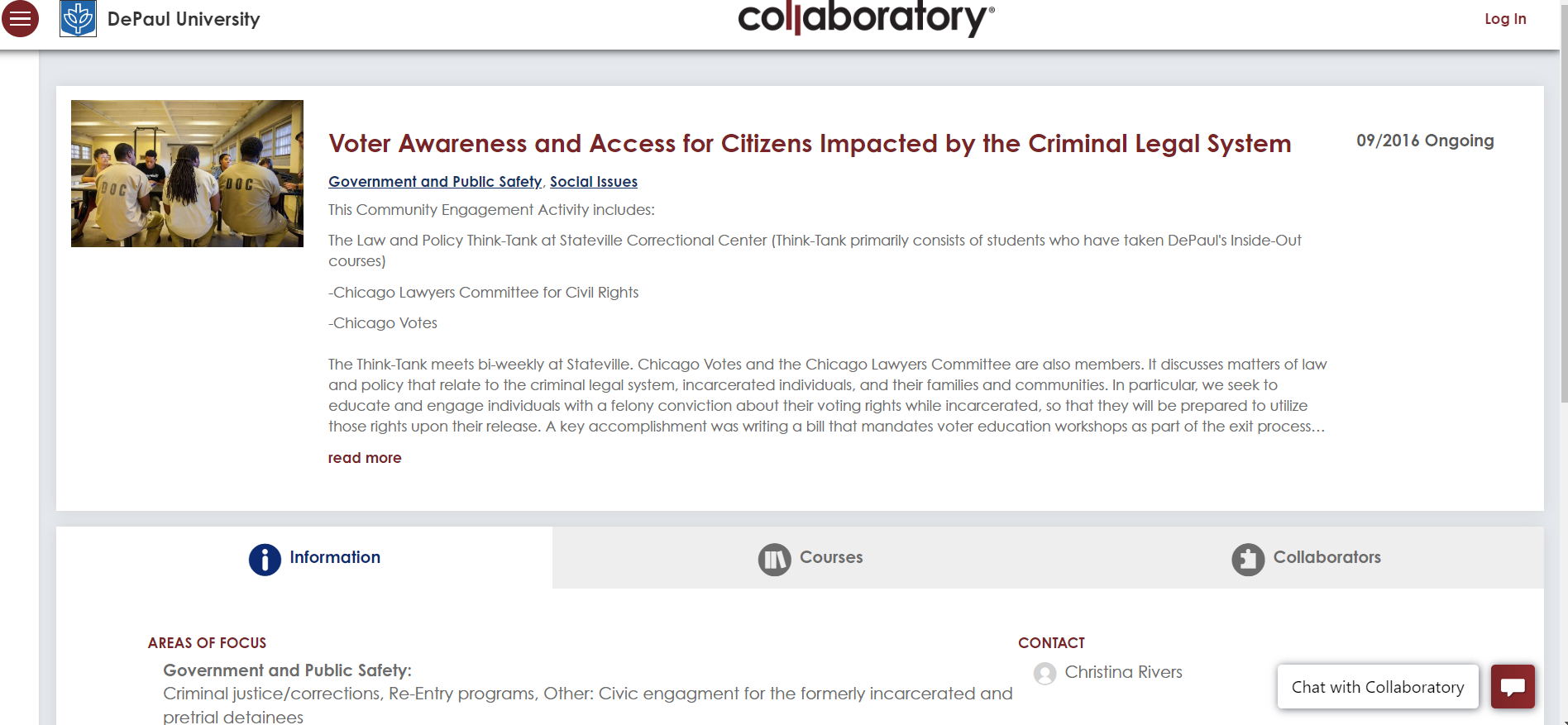DePaul's mission states that the university supports the integral human development of its students "through its commitment to outstanding teaching, academic excellence, real world experience, community engagement, and systemic change." In 2021, the university launched Collaboratory, a powerful tool for documenting and researching the institution’s commitment to community engagement through teaching, research and service.
.png)
Collaboratory is an online platform that provides a space for faculty and staff to collect and share work essential to the university's mission. This includes courses that integrate service learning pedagogy and research, technical assistance and advocacy activities done collaboratively with community partners across Chicago and the world. Collaboratory is essentially a place for DePaul to track, report, connect and plan community engagement and public service activities.
“We see great potential in having a centralized location where we can keep track of community
 Barbara Smith, Associate Director, Steans Center
Barbara Smith, Associate Director, Steans Centerengagement and public service," says Barbara Smith, Associate Director of Compliance
, Evaluation, and Community Partnership Management at the Steans Center. Smith plays a leading role in administering Collaboratory for DePaul, which includes helping faculty learn how to use the system. “It's really a tool that gives us a footprint into how DePaul is doing community engagement," she said. Smith and her team are working with colleges, schools and non-academic units across the university to help them learn how they can benefit from contributing their community engagement activities into the new system.
Collaboratory will allow us as a university to more easily tell our community engagement story to each other and the world.
The platform guides users step by step, enabling them to share the who, what, and why of community engagement and public service work. Users quickly see that it's also a way to learn about how and where others at the university are engaging with communities. The system includes a search tool and maps that allow users to learn about the many ways and places faculty, staff and students are fulfilling the institution's mission. Users can search by college or school, by department, by faculty or staff member, or they can explore topics such as housing, youth violence and education. "The system helps facilitate connections between faculty looking for ways to connect across disciplines for community-engaged research and teaching in ways that were previously not possible," says Howard Rosing, Executive Director of the Steans Center. "Collaboratory will allow us as a university to more easily tell our community engagement story to each other and the world."

Collaboratory was first developed over a decade ago at the University of North Carolina Greensboro out of frustrations by faculty to capture data about community
engagement. Now the tool is nationally administered with universities across the country using
the platform. “Data is a language that everyone speaks – internal and
external audiences, funders, and others," says Lauren Wendling, Director
of Institutional Success with Collaboratory. “This is really a tool
that can help educators tell their story. That story can be used to
learn about what others are doing, bring students to campus, raise
funds, and in many other ways." Collaboratory is a strong fit at DePaul,
she adds, “because it gets across the message that engagement is at the
heart of what the university is about." Rosing further notes,
"Researchers will benefit from data as they look to build collaborations
across the university for proposals; fundraisers will be able to learn
about ways in which faculty, staff and students are working on projects
relevant to grant proposals; students will be able to learn about ways
that DePaul faculty, staff and students are already engaging in community work that is of direct
interest to their studies and career interests. The uses are seemingly
endless!"
Many at DePaul have echoed a common theme about the
positive impact the tool can have on faculty, students, and the
university. Most in academia work in silos without time, resources, or
tools to learn about community engagement activities outside their
disciplines. Accessing such information becomes easier as
Collaboratory grows as a repository of interdisciplinary data. Smith and
her team are working hard to ensure that the system does not appear as
another administrative task, but rather becomes part of the culture of
DePaul, part of contributing to the mission. She sees her job as making
it easy for faculty and staff to want to submit community engagement activities. “People are finding that it's easy to
work with," says Linda Bendixen, Steans Center Department Assistant and a
member of Smith's team. “It's catching on.
Once more and more people start using it and interacting, I feel it's
just going to grow exponentially."
Perhaps most importantly at
DePaul, Collaboratory provides a resource for teaching. DePaul faculty
have a tool to guide students to learn about communities through the
lens of DePaul's community engagement activities. The tool has applications
for courses that integrate service learning pedagogy, First-Year Program
courses (e.g., The Chicago Quarter), and any course that seeks
to more deeply understand critical social, economic, and political
issues. With Collaboratory, faculty have a resource to explore with
students how DePaul is directly engaged in those issues.

“This
is a way for us to quantify what we are working toward and how DePaul is
engaging in its spirit of service," says Molly Brown, Associate
Professor of Clinical-Community Psychology as well as the HARC Lab
Director at the university (HARC stands for Homelessness, Advocacy,
Research, and Collaboration). “You can see vast numbers of projects,
courses and research activities that are examples of community
engagement on the site. We are a very community-engaged university, but
it's not always easy to see what that looks like." Brown adds that
“we don't always know what opportunities there are for collaboration at
the university and in communities. Collaboratory is a great way for
instructors and researchers to connect with one another. You can
literally just start browsing and happen upon something. It can help you
find people and organizations you may want to connect with."
Euan Hague, professor in the Department of Geography and Director of the School of Public Service, compares how the platform works to what existed before. "Before, there was no systematic way at all of knowing what people were doing, it was very ad hoc," he says. Now, it's quick and easy. “Let's say you wanted to know who is working on homeless issues at the university. You can do a quick search and find out who is doing that – it's a way to learn right away about people who might be in your network at the university and teach in different departments."
Christina Rivers, Associate Professor of Political Science, says that Collaboratory also could provide key information to external audiences, including journalists, who want more in-depth information than they are likely to find on department websites or other databases. “Collaboratory can be a much more thorough and interactive version of what an individual's website could be," she says. “It's also a good way to find out who you could possibly collaborate with at DePaul." Rivers teaches a course within DePaul's Inside-Out Prison Exchange Program, and also collaborates on a law and policy think tank initiative that meets bi-weekly at Stateville Correctional Center in Joliet, Illinois. In Collaboratory, “Voter Awareness and Access for Citizens Impacted by the Criminal Justice System" describes the initiative where students from campus (primarily those who have taken Inside-Out courses) and incarcerated individuals at Stateville meet to discuss matters of law and policy that relate to the criminal justice system. Community organizations such as Chicago Lawyers Committee for Civil Rights and Chicago Votes also participate.

Emily Tamblyn, who manages community partnerships for the Master in Public Health Program, says public health - like many other programs at DePaul – is often interdisciplinary in nature, which can make it a great fit for Collaboratory, since information from many disciplines overlaps on the website. “It's a robust tool," she says. “Students can go in and look for opportunities or do a search by topic or community. It's much easier and more efficient than just reaching out to another department or hearing something from the grapevine."
Declan Cavanaugh, who recently completed an undergraduate degree in Environmental Studies, has been involved with Collaboratory through supporting DePaul's Council on Community Engagement. “There's so much community engagement going on at DePaul, and this gives DePaul's community the potential to see what other colleagues are doing, as well as who is working on the same issues or in the same neighborhoods. It's also a way to make the gathering of information more centralized." Cavanaugh says that it's important to “spread the word" about this tool. “Once people learn about it, they will see its true potential. Shared knowledge is what the Collaboratory fosters." Cavanaugh says it's easy to use. “Honestly, I'm reminded of how quickly people can be trained on it – like in a half-hour. It's a relatively simple platform."
Monica Ramos manages Collaboratory contributions for the Egan Office for Urban Education & Community Partnerships, a division of the Steans Center. She manages graduate students who are delegated to enter project data into the platform. “Collaboratory helps us see our efforts more tangibly," she says. “It's a venue for us to be out there in a different way – so people realize what kind of service we provide in the communities we are invited into." Ramos describes Collaboratory as "an x-ray or a map of the institution and the different components within it." She adds that the platform could potentially be used in an even more expansive way. "I can see sharing the story of global engagement through collaboration across the globe. How can we use this tool to identify opportunities for community engagement, teaching and learning, not just on the local level, but nationally and on a global scale?"
Students can act as proxies for DePaul faculty and staff to assist in entering and updating Collaboratory activities. Graduate student Devan Keys, a Community School Organizer with the Egan Office, worked with Ramos while attaining a master's degree in clinical mental health. “I serve as the connector between DePaul resources and the North Lawndale community. Every quarter I am asked to document our engagement in Collaboratory. I put in different kinds of engagements – sometimes they are events, fliers, pictures. If others were to look at that, they would see more about what we are doing and the impact of what's going on in communities. It gives us a tool that helps us reflect on different things we've done and what we've worked on. It's so important to document our engagement. Why? Because it helps tell our story."
Collaboratory is open to all faculty and staff; log on using Campus Connect ID and password. For more information and assistance with Collaboratory, contact Barbara Smith at the Steans Center, bsmith@depaul.edu .